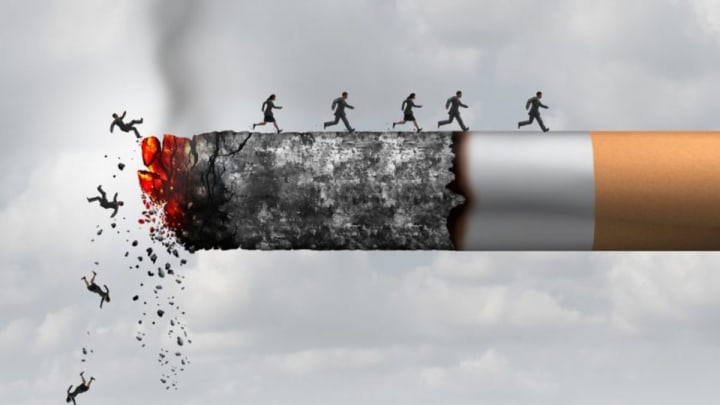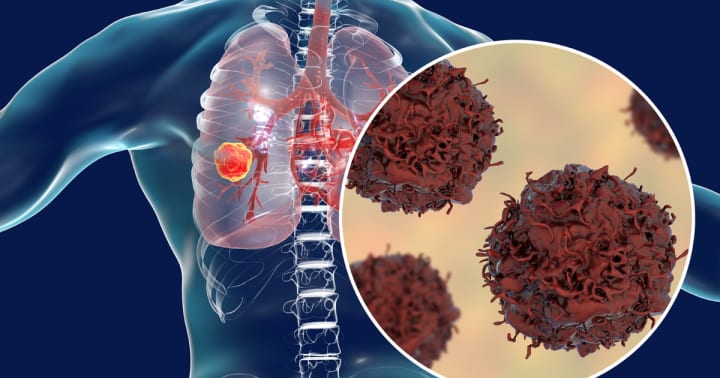The Real Effects of Smoking On Our Lungs
Our health is harmed by cigarettes. We've known about the effects of smoking for decades, so this isn't exactly startling news. However, in detail, what effects do cigarettes have on us? Let's see what happens when their constituent parts are combined. Let's examine its impact on the lungs.

The leading cause of cancer-related death worldwide is lung cancer. On the other side, lung cancer screening can help save lives. How they pass through our systems and the physiological advantages of quitting smoking. Each time you breathe in the smoke, over 5,000 chemical compounds come into contact with your body's tissues. Read How Smoking Kills Our Lungs to learn more.
Every time you smoke a cigarette, toxic gases enter your lungs. After that, they go into your bloodstream and spread to every organ in your body.
What's in a cigarette, exactly?
Nicotine and a variety of other compounds found in tobacco leaves are utilized to produce cigarettes. As tobacco and its components burn, thousands of dangerous chemicals, including more than 40 known carcinogens, are produced. Smoke from cigarettes contains trace amounts of cancer-causing radioactive particles, lethal compounds like carbon monoxide and nitrogen oxide, and carbon dioxide.
Smokeless tobacco products like chewing tobacco and snuff are also dangerous forms of tobacco, as are cigars, pipes, and snuff. Nicotine, an addictive chemical, is found in tobacco. After inhaling tobacco smoke, nicotine rushes through your circulation to your brain, resulting in a pleasant sensation. Regular nicotine exposure causes your brain to get desensitized, which makes you need increasing amounts of nicotine just to feel normal.
Tobacco Consumption Results in Death

Smokers experience a younger death than non-smokers do. In actuality, smoking cigarettes causes one out of every five fatalities in the US. Smoking increases your risk of serious health issues like heart disease, heart attack, stroke, lung cancer, and death from chronic obstructive pulmonary disease.
Smoking and Cardiovascular Disease
Cardiovascular disease is brought on by smoking. Nicotine boosts the release of epinephrine, a hormone that raises blood pressure when it passes through your adrenal glands. In addition, the lining of the inner walls of your arteries might be harmed by carbon monoxide and nicotine.
A condition known as atherosclerosis can develop at these lesion sites where fatty deposits called plaque can form and become large enough to narrow the arteries and significantly reduce blood flow. When you have coronary artery disease, atherosclerosis narrows the arteries that supply your heart, decreasing the oxygen flow to your heart muscles and increasing your chance of having a heart attack.
Smoking raises your risk of blood clots because it causes platelets in your blood to clump together. When atherosclerotic plaques obstruct the main arteries in your arms and legs as a result of smoking, it results in peripheral vascular disease. A bulging or weakening of your aorta which passes through your belly brought on by smoking is known as an abdominal aortic aneurysm.
Smoking and Lung Disease
Two essential lung components are harmed by smoking. Your airways, also known as bronchial tubes, and tiny air sacs, or alveoli, With each breath, air travels down your windpipe, also known as the trachea, and into your lungs through your bronchial tubes. Thousands of small alveoli in the air then release oxygen into the bloodstream.
Your bloodstream releases trash called carbon dioxide. Cilia are tiny, hair-like protrusions that line your bronchial tubes and remove potentially harmful particles. The bronchial tube lining becomes irritated by cigarette smoke, which causes it to swell and secrete mucus. Additionally, cigarette smoke slows down the movement of your cilia, enabling some smoke and mucus to stay in your lungs. While you sleep, some of your cilia repair themselves and start to expel more irritants and mucus from your lungs.
When you wake up, your body tries to get rid of this material by making you cough constantly, a symptom known as "smoker's cough." Chronic bronchitis arises as your cilia cease functioning, your airways obstruct with scar tissue and mucus, breathing becomes challenging, and your lungs become more susceptible to illness. Additionally, smoking damages your alveoli, making it harder for oxygen and carbon dioxide to exchange with your blood over time.
Emphysema, a condition where you must gasp for every breath and wear an oxygen tube under your nose to breathe, may occur if your blood does not acquire enough oxygen.
(Chronic Obstructive Pulmonary Disease) is a Type of Lung Ailment (COPD)
Chronic obstructive pulmonary disease, or COPD, is the term used to describe chronic bronchitis and emphysema. COPD is a condition that gradually impairs breathing and has no known treatment.
Smoking And Cancer

At least 40 carcinogens, including cyanide, formaldehyde, benzene, and ammonia, which are all known to cause cancer, are found in cigarette smoke. Your body's healthy cells develop, divide, and eventually expire. DNA, the genetic material located inside each cell, serves as the process' direction.
The DNA in your healthy cells can be harmed by the toxic substances in cigarettes. As a result, your body's damaged cells generate more dangerous cells that can invade other organs. Over a million new cases of lung cancer are identified each year, making it the most common cancer in the world.
Smoking cigarettes exposes you to hazardous compounds that can harm your kidney, bladder, uterus, cervix, mouth, larynx, throat, esophagus, stomach, and pancreas.
Other Smoking-Related Health Issues
Smoking can cause infertility in both men and women. A pregnant woman who smokes increases the risk of low birth weight, miscarriage, early delivery, stillbirth, infant mortality, and sudden infant death syndrome by exposing her unborn child to the harmful chemicals in cigarettes.
Smoking is also dangerous if a mother is nursing. In infants exposed to nicotine through breast milk, symptoms such as agitation, a rapid heartbeat, vomiting, disturbed sleep, and diarrhea are possible. There are numerous additional harmful health effects of smoking.
- Women's low bone density
- Hip fractures are more common in women.
- Gum disease is a condition that affects the gums
- Frequently resulting in tooth loss and surgery,
- Dysfunction of the immune system
- Impotence in men is a condition that occurs when a man is unable to
- Wound healing takes longer than usual.
For Those Who Quit Smoking

There are several benefits, including long-lasting and very immediate bodily impacts. After 20 minutes of not smoking, a smoker's heart rate and blood pressure start to return to normal. After 12 hours, carbon monoxide levels stabilize, increasing the blood's capacity to carry oxygen.
One day after quitting, the risk of a heart attack starts to decline just as blood pressure and heart rate return to normal. After two days, the nerve endings that regulate taste and smell start to recover. The lungs get better, with less coughing and breathlessness, after about a month. The delicate, hair-like cilia that line the airways and lungs start to heal within a few weeks, and within nine months, they have entirely recovered, increasing infection resistance. After one year of quitting, the risk of heart disease is cut in half as blood vessel function improves.
After five years, both the risk of stroke and the likelihood that a clot will form have significantly decreased. The body's capacity to repair DNA is recovered after 10 years, which reduces the risk of developing fatal lung cancer by half. The risk of getting coronary heart disease is almost comparable to that of a nonsmoker after fifteen years. It serves no purpose to suggest that everything is easy. When you stop smoking, withdrawal from nicotine can make you anxious and depressed. Such side effects are typically relatively momentary. And giving up is getting simpler as a result of an expanding range of technology.
Gum, skin patches, lozenges, and sprays that contain nicotine replacement therapy can help people stop smoking. They reduce withdrawal symptoms without the use of any other possibly harmful medicines by activating nicotine receptors in the brain.
Finally, support groups, cognitive behavioral therapy, and moderate-intensity exercise can all help smokers quit. That's fantastic news because it puts your body and mind on the path to healing.
About the Creator
Ahamed Thousif
🌟 Welcome to the realm of exploration, where communities come alive through the power of words! 📚✨ Join me as we embark on a journey to discover the vibrant tapestry of stories and Poems.
VISIT - "MY FOOD BLOG"






Comments
There are no comments for this story
Be the first to respond and start the conversation.